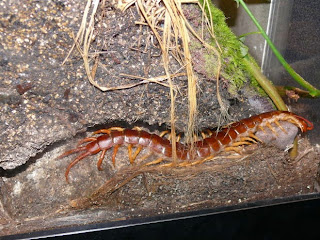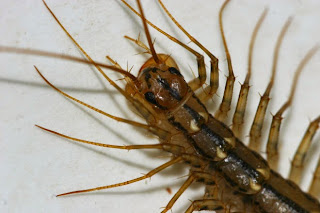According to some scientific findings about centipedes, most of their species are not venomous enough to kill humans or large animals unless they are allergic to the bite. But among all the species, one among the most threatening of their kind is the "Scolopendra Gigantea" which is more commonly known as the "Amazonian Giant Centipede".
Amazonian giant centipedes find their perfect dwelling place or habitat at the tropical climate of South America's Amazon jungle.
A scolopendra gigantea can actually grow into a massive size which makes it unique and quite fascinating especially to any centipede pet owners. An adult or fully matured scolopendra gigantea can reach over 35 centimeters in length. This is comparable to the length of a man's forearm. And with such incredible size, anyone who hasn't encountered this kind of centipede will surely tremble and run away in fear.
The shell-color of an amazonian giant centipede is commonly "red-maroon" or "dark-brown". Most of them actually possess dark colors. No one is able to confirm yet if there's an amazonian giant centipede with bright colors.
When it comes to the legs, a fully matured scolopendra gigantea usually consists of around 46 color-yellow tinted legs. Common to all centipedes, if it happens that they lost one of their legs, they actually have the capability to grow a new one.
As a hunter or predator of the jungle, a giant amazonian centipede possess the power of speed to run around unnoticed. Due to this characteristics, some scientists describe them as "Swift Runners". Other than their speedy movement, these creatures are also good climbers. With their several pairs of legs, it allows them to climb through vertical surfaces with ease.
All kinds of centipedes are actually both "carnivores" and "herbivores" (they eat dead plants). However, they are more categorized as carnivorous creatures because they prefer to eat meat. Probably, meat taste better to their appetite.
Small-sized centipedes have a long lists on their food menu which are other smaller creatures particularly insects as their prey. Some of these insects includes ants, beetles, spiders and termites. Common small-sized centipedes are the "House Centipedes" which can be observed running around the corners of an untidy room.
Unlike house centipedes, scolopendra gigantea does not invade house premises where they prefer to stay in the jungle. Due to their large sizes, they are surprisingly capable of hunting large rats in the rice-field. In fact, they can also hunt down small snakes. But above all, the most impressive display of their hunting skill is that, they can hunt bats living inside caves.
According to some biologists, the amazonian giant centipedes have highly developed quick responses. This is what makes them as "fierce hunters" and the reason why they can catch a flying bat in an instant.
Today, there's a growing number of exotic pet owners who are adding giant centipedes into their collections. If you are one of them and it's your first-time to own one of this kind of pet, you are advised not to touch or handle it with your bare hands. You have to know that a slight venom of the creature can cause severe reactions into your skin.

Although, some pet owners are able to handle their giant centipedes without getting harmed or bitten it's because they already have good handling experiences.
Finally, do you own a scolopendra gigantea giant centipede? If you do then it would be really grateful if you can share to us your experiences especially on how you handle and take good care of your pet.
Amazonian giant centipedes find their perfect dwelling place or habitat at the tropical climate of South America's Amazon jungle.
 |
| Amazon Jungle |
A scolopendra gigantea can actually grow into a massive size which makes it unique and quite fascinating especially to any centipede pet owners. An adult or fully matured scolopendra gigantea can reach over 35 centimeters in length. This is comparable to the length of a man's forearm. And with such incredible size, anyone who hasn't encountered this kind of centipede will surely tremble and run away in fear.
The shell-color of an amazonian giant centipede is commonly "red-maroon" or "dark-brown". Most of them actually possess dark colors. No one is able to confirm yet if there's an amazonian giant centipede with bright colors.
When it comes to the legs, a fully matured scolopendra gigantea usually consists of around 46 color-yellow tinted legs. Common to all centipedes, if it happens that they lost one of their legs, they actually have the capability to grow a new one.
As a hunter or predator of the jungle, a giant amazonian centipede possess the power of speed to run around unnoticed. Due to this characteristics, some scientists describe them as "Swift Runners". Other than their speedy movement, these creatures are also good climbers. With their several pairs of legs, it allows them to climb through vertical surfaces with ease.
Scolopendra Gigantea are Carnivorous Creatures
All kinds of centipedes are actually both "carnivores" and "herbivores" (they eat dead plants). However, they are more categorized as carnivorous creatures because they prefer to eat meat. Probably, meat taste better to their appetite.
Small-sized centipedes have a long lists on their food menu which are other smaller creatures particularly insects as their prey. Some of these insects includes ants, beetles, spiders and termites. Common small-sized centipedes are the "House Centipedes" which can be observed running around the corners of an untidy room.
Unlike house centipedes, scolopendra gigantea does not invade house premises where they prefer to stay in the jungle. Due to their large sizes, they are surprisingly capable of hunting large rats in the rice-field. In fact, they can also hunt down small snakes. But above all, the most impressive display of their hunting skill is that, they can hunt bats living inside caves.
According to some biologists, the amazonian giant centipedes have highly developed quick responses. This is what makes them as "fierce hunters" and the reason why they can catch a flying bat in an instant.
Today, there's a growing number of exotic pet owners who are adding giant centipedes into their collections. If you are one of them and it's your first-time to own one of this kind of pet, you are advised not to touch or handle it with your bare hands. You have to know that a slight venom of the creature can cause severe reactions into your skin.

Although, some pet owners are able to handle their giant centipedes without getting harmed or bitten it's because they already have good handling experiences.
Finally, do you own a scolopendra gigantea giant centipede? If you do then it would be really grateful if you can share to us your experiences especially on how you handle and take good care of your pet.











